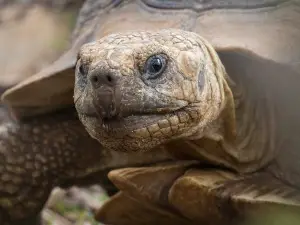
Turtle shells are usually a vibrant brown or green color, you may start to worry if a once vibrant turtle shell starts to become dull and pale, this is concerning. Understanding why your pet’s shell color changes in this way will help you address the issue.
This article looks into why your turtle is pale.
Table of Contents
Why is my turtle pale?
Vibrant-colored turtle shells look healthy and strong and dull-colored and pale turtle shells can look sickly. This article will help you figure out why this change happened so your pet’s shell color back to normal.
Here is why this may be happening with your pet:
Shedding:
Turtles have thick bony plates, called scutes, on their shells and these scutes shed.
If you notice a lightening of your pet’s shell edges, from a darker color to a white or yellow, then this may be happening because the scutes on the shell are about to shed.
In some cases, the whole turtle’s shell may look very faded, dull, and almost transparent
The shell of the turtle will go back to normal once the shedding is complete.
What to do:
Shedding is a normal process for turtles that happens to every one of them but it’s good to keep an eye on the animal to make sure the shedding process goes flawlessly.
The scutes of younger turtles will come off very easily but the scutes of older turtles may take more time.
Don’t pull the scutes off but what you can do with your older turtles is use a toothbrush to rub the scutes, this will help them come off easier.
Not enough UV light:
Another reason why your turtle may be turning pale may be because the turtle is not receiving enough UV light
These animals need UVB light in order to synthesize vitamin D3 which is essential for calcium metabolism and overall shell health. A lack of this will result in a pale or dull shell.
What to do:
The strength of the UV light in your pets tank will weaken overtime this is why replacing these lights regularly is a must. You’d need to purchase a good UVB light for your pet’s enclosure.
These lights also need to be on for 8 to 12 hours a day for the animals to be exposed to enough light.
You can alternatively allow your pet to have some time out in the sun, the UV rays of the sun are much stronger than the UV rays created by bulbs
Incorrect nutrition:
Incorrect nutrition is another reason why your pet may be turning pale.
Nutrients play a big role in the health of your turtle and its appearance, if your pet isn’t eating well then you’ll notice negative changes in the animal’s appearance namely its shell color and vibrancy
What’s to do:
Improving your pet’s diet will get the shell back to normal over time.
Improve your pet’s health by making sure that it eats good quality pellets and make sure that the animal is eating enough. Give your pet, at each feeding, about the amount of food that will fit inside its head.
Supplementing your pet’s diet with vegetables and other foods will also be helpful
If you enjoyed this article then you may also be interested in other turtle/tortoise related articles. Here are some articles that you may be interested in: Why Is My Turtle Acting Weird?, Why Is My Turtle Squeaking?, Why Is My Turtle Gagging?, Why Is My Turtle Pooping So Much?, Why Is My Turtle Active?, Tortoise Left White Poop In Bath, Why Is My Turtle So Jumpy?, Why Is My Turtle Going In Circles?, Why Is My Turtle Always Begging For Food?

